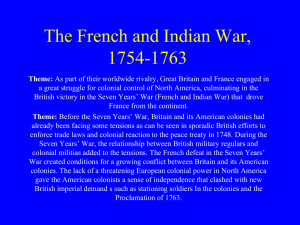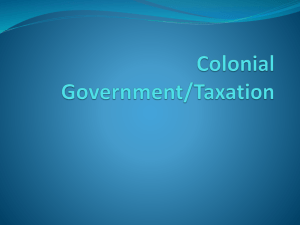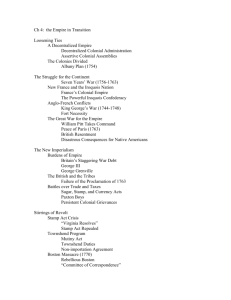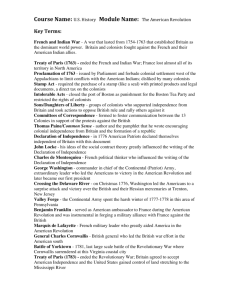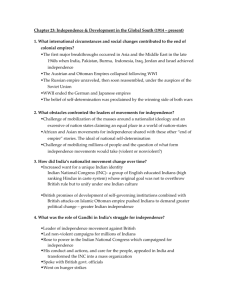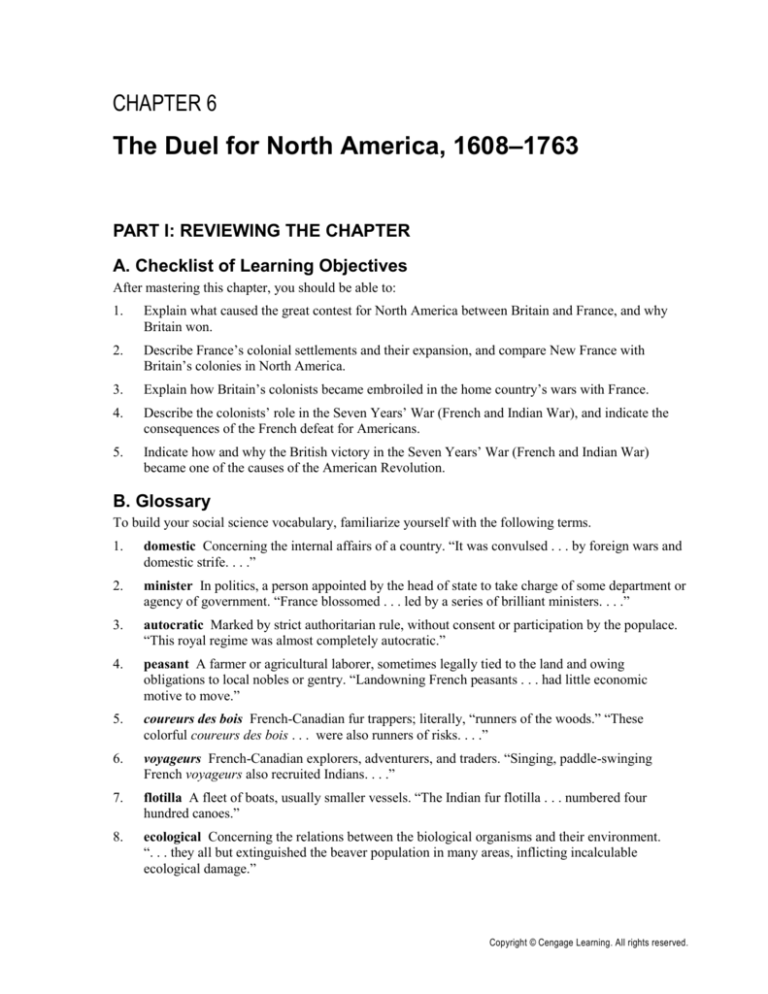
CHAPTER 6
The Duel for North America, 1608–1763
PART I: REVIEWING THE CHAPTER
A. Checklist of Learning Objectives
After mastering this chapter, you should be able to:
1.
Explain what caused the great contest for North America between Britain and France, and why
Britain won.
2.
Describe France’s colonial settlements and their expansion, and compare New France with
Britain’s colonies in North America.
3.
Explain how Britain’s colonists became embroiled in the home country’s wars with France.
4.
Describe the colonists’ role in the Seven Years’ War (French and Indian War), and indicate the
consequences of the French defeat for Americans.
5.
Indicate how and why the British victory in the Seven Years’ War (French and Indian War)
became one of the causes of the American Revolution.
B. Glossary
To build your social science vocabulary, familiarize yourself with the following terms.
1.
domestic Concerning the internal affairs of a country. “It was convulsed . . . by foreign wars and
domestic strife. . . .”
2.
minister In politics, a person appointed by the head of state to take charge of some department or
agency of government. “France blossomed . . . led by a series of brilliant ministers. . . .”
3.
autocratic Marked by strict authoritarian rule, without consent or participation by the populace.
“This royal regime was almost completely autocratic.”
4.
peasant A farmer or agricultural laborer, sometimes legally tied to the land and owing
obligations to local nobles or gentry. “Landowning French peasants . . . had little economic
motive to move.”
5.
coureurs des bois French-Canadian fur trappers; literally, “runners of the woods.” “These
colorful coureurs des bois . . . were also runners of risks. . . .”
6.
voyageurs French-Canadian explorers, adventurers, and traders. “Singing, paddle-swinging
French voyageurs also recruited Indians. . . .”
7.
flotilla A fleet of boats, usually smaller vessels. “The Indian fur flotilla . . . numbered four
hundred canoes.”
8.
ecological Concerning the relations between the biological organisms and their environment.
“. . . they all but extinguished the beaver population in many areas, inflicting incalculable
ecological damage.”
Copyright © Cengage Learning. All rights reserved.
Chapter Error! Unknown document property name.: Error! Unknown document property name.
9.
51
mutinous Concerning revolt by subordinate soldiers or seamen against their commanding
officers. “But he failed to find the Mississippi delta, . . . and was murdered by his mutinous
men.”
10. strategic Concerning the placement and planned movement of large-scale forces so as to gain
political or military advantage in confrontation with the enemy. (By contrast, tactical refers to
specific, variable, smaller-scale methods of waging conflict or achieving strategic objectives.)
“Commanding the mouth of the Mississippi River, this strategic semitropical outpost also tapped
the fur trade of the huge interior valley.”
11. guerilla warfare Unconventional combat waged by small military units using hit-and-run tactics.
“. . . so the combatants waged a kind of primitive guerilla warfare.”
12. sallies (sally) In warfare, very rapid military movements, usually by small units, against an enemy
force or position. “For their part the British colonists failed miserably in sallies against Quebec
and Montreal. . . .”
13. siege A military operation of surrounding and attacking a fortified place, often over a sustained
period. “After a ten-hour siege he was forced to surrender. . . .”
14. regulars Trained professional soldiers, as distinct from part-time militia or conscripts. “. . . they
had fought bravely alongside the crack British regulars. . . .”
15. commissions An official government certification granting a commanding rank in the armed
forces. “. . . the British refused to recognize any American militia commission. . . .”
PART II: CHECKING YOUR PROGRESS
A. True-False
Where the statement is true, circle T; where it is false, circle F.
1.
T
F
French colonization was late developing because of the nation’s internal religious and
political conflicts.
2.
T
F
The French Empire in North America rested on an economic foundation of forestry and
sugar production.
3.
T
F
Early imperial conflicts in North America often saw the French and their Indian allies
engaging in guerrilla warfare against British frontier outposts.
4.
T
F
Colonists in British North America managed to avoid direct involvement in most of
Britain’s world wars until the French and Indian War.
5.
T
F
In the early seventeenth century, both France and England committed large regular
forces to what they considered the crucial struggle for control of North America.
6.
T
F
George Washington’s battle at Fort Necessity substantially resolved the issue of control
of the Ohio Valley.
7.
T
F
The delegates to the Albany Congress demonstrated a strong desire to overcome
differences among different colonies and to control their own affairs.
8.
T
F
William Pitt’s successful strategy was to concentrate British forces and focus on
capturing the French strongholds of Louisbourg, Quebec, and Montreal.
9.
T
F
British regular troops under General Braddock succeeded in capturing the key French
forts in the Ohio Valley.
Copyright © Cengage Learning. All rights reserved.
Chapter Error! Unknown document property name.: Error! Unknown document property name.
52
10. T
F
The French and Indian War left France with only Louisiana as a remnant of its oncemighty North American empire.
11. T
F
American soldiers gained new respect for British military men after the British success
against the French.
12. T
F
The American colonists enthusiastically united in patriotic support of the British cause
against the French.
13. T
F
The removal of the French threat made American colonists more secure and therefore
less reliant on the mother country for protection.
14. T
F
A British commander used the biological warfare tactic of distributing blankets
infected with smallpox to suppress Pontiac’s Indian uprising.
15. T
F
The British government’s attempt to prohibit colonial expansion across the
Appalachian Mountains aroused colonial anger and defiance of the law.
B. Identification
Supply the correct identification for each numbered description.
1.
__________
French Protestants who were granted toleration by the Edict of Nantes in 1598
but not permitted to settle in New France
2.
__________
Absolute French monarch who reigned for seventy-two years
3.
__________
Animal whose pelt provided great profits for the French empire and enhanced
European fashion at enormous ecological cost
4.
__________
Catholic religious order that explored the North American interior and sought
to protect and convert the Indians
5.
__________
Far-running, high-living French fur trappers
6.
__________
Part of a certain British naval officer’s anatomy that set off an imperial war
with Spain
7.
__________
Strategic French fortress conquered by New England settlers, handed back to
the French in 1748, and finally conquered again by the British in 1759
8.
__________
Inland river territory, scene of fierce competition between the French and landspeculating English colonists
9.
__________
Bloodiest European theater of the Seven Years’ War, where Frederick the
Great’s troops drained French strength away from North America
10. __________
Unification effort that Benjamin Franklin nearly led to success by his eloquent
leadership and cartoon artistry
11. __________
Military aide to British General Braddock who defended the frontier after
Braddock’s defeat
12. __________
Fortress boldly and successfully assaulted by General Wolfe, spelling doom for
New France
13. __________
Prussian king whose defeats of the French and others in Germany provided a
key to the British victory in the Seven Years’ War
Copyright © Cengage Learning. All rights reserved.
Chapter Error! Unknown document property name.: Error! Unknown document property name.
14. __________
Allies of the French against the British, who continued to fight under Pontiac
even after the peace settlement in 1763
15. __________
The larger European struggle of which the French and Indian War was part
53
C. Matching People, Places, and Events
Match the person, place, or event in the left column with the proper description in the right column by
inserting the correct letter on the blank line.
a.
Advocate of colonial unity at a 1754 meeting in
upstate New York
b.
British document that aroused colonial anger
but failed to stop frontier expansion
c.
French colonists in Nova Scotia brutally
uprooted by the victorious British and shipped
to Louisiana
d.
Conflict that started with the War of Jenkins’s
Ear and ended with the return of Louisbourg to
France
General Braddock
e.
Strategic French outpost at the mouth of the
Mississippi
William Pitt
f.
Indian leader whose frontier uprising caused the
British to attempt to limit colonial expansion
g.
Blundering British officer whose defeat gave
the advantage to the French and Indians in the
early stages of their war
h.
The Father of New France, who established a
crucial alliance with the Huron Indians
i.
Site of the death of Generals Wolfe and
Montcalm, where France’s New World empire
also perished
j.
Strategic French stronghold; later renamed after
a great British statesman
k.
Militia commander whose frontier skirmish in
Pennsylvania touched off a world war
l.
Site of a meeting that proposed greater unity
and home rule among Britain’s North American
colonies
m.
Conflict that began with George Washington’s
skirmish in Ohio and ended with the loss of
France’s North American empire
n.
French empire builder who explored the
Mississippi Basin and named it after his
monarch
o.
Splendid British orator and organizer of the
winning strategy against the French in North
America
1.
___
Samuel de Champlain
2.
___
Robert de la Salle
3.
___
Albany
4.
___
War of Austrian Succession
5.
___
Fort Duquesne
6.
___
George Washington
7.
___
Benjamin Franklin
8.
___
9.
___
10. ___
Plains of Abraham
11. ___
Seven Years’ War
12. ___
Pontiac
13. ___
Proclamation of 1763
14. ___
New Orleans
15. ___
Acadians (Cajuns)
Copyright © Cengage Learning. All rights reserved.
Chapter Error! Unknown document property name.: Error! Unknown document property name.
54
D. Putting Things in Order
Put the following events in correct order by numbering them from 1 to 10.
1.
__________
A Virginia militia commander attempts an unsuccessful invasion of the Ohio
Valley.
2.
__________
The Great Commoner takes command of the British government and its war
effort.
3.
__________
Toleration of French Huguenots brings religious peace to France.
4.
__________
New France is founded, one year after Jamestown.
5.
__________
Britain issues a proclamation to prohibit colonial expansion and thereby
prevent another Indian war.
6.
__________
The second world war between France and Britain ends in British victory and
the acquisition of Acadia.
7.
__________
British victory on the Plains of Abraham seals the fate of New France.
8.
__________
Return of Louisbourg fortress at the end of King George’s War angers colonial
New Englanders
9.
__________
War begins badly for the British when Braddock fails to take Fort Duquesne.
10. __________
A great empire builder explores Louisiana and claims it for the French king.
Copyright © Cengage Learning. All rights reserved.
Chapter Error! Unknown document property name.: Error! Unknown document property name.
55
F. Matching Cause and Effect
Match the historical cause in the left column with the proper effect in the right column by writing the
correct letter on the blank line.
Cause
Effect
1.
___
The French fur trade
a.
2.
___
The four world wars between 1688
and 1763
Resulted in decisive French defeat and
British domination of North America
b.
Prompted widespread Indian assaults
on the weakly defended colonial
frontier
3.
___
Competition for land and furs in the
Ohio Valley
c.
Led to Washington’s expedition and
battle with the French at Fort Necessity
4.
___
The summoning of the Albany
Congress by the British
d.
5.
___
William Pitt’s assumption of control
of British government and strategy
Heightened colonial anger and
encouraged illegal westward expansion
e.
6.
___
Wolfe’s victory over Montcalm at
Quebec
Increased American military
confidence and resentment of British
redcoats
___
The colonial militia’s military success
in the French and Indian War
f.
7.
Decimated beaver populations while
spreading the French empire
g.
8.
___
Colonial American smuggling and
trading with French enemy
Were echoed by four small wars
between French and British subjects in
North America
9.
___
British issuance of the Proclamation
of 1763
h.
Represented the first major attempt at
intercolonial unity
10. ___
Braddock’s defeat at Fort Duquesne
i.
Increased British government’s disdain
for colonial Americans and raised
doubts about their loyalty to the empire
j.
Ended a string of defeats and turned
the French and Indian War in Britain’s
favor
Copyright © Cengage Learning. All rights reserved.
Chapter Error! Unknown document property name.: Error! Unknown document property name.
56
Map Mastery
Map Discrimination
Using the maps and charts in Chapter 6, answer the following questions.
1.
France’s American Empire at the Greatest Extent, 1700: Around which great river valley was
New France first colonized?
2.
France’s American Empire at the Greatest Extent, 1700: Which French colonial settlement on the
Great Lakes linked the St. Lawrence and Mississippi river basins?
3.
Fur-Trading Posts: Along which river, besides the Mississippi, were the greatest number of
French fur-trading posts located?
4.
The Nine World Wars: How many years of peace did Britain and France enjoy between France’s
loss of Acadia in the War of Spanish Succession and the beginning of the War of Austrian
Succession?
5.
Scenes of the French Wars: The attacks on Schenectady and Deerfield occurred during attacks
from which French Canadian city?
6.
The Ohio Country, 1753–1754: Fort Duquesne was located at the intersection of which two rivers
(which unite at that point to form a third river)?
7.
Events of 1755–1760: Which French Canadian stronghold did not finally fall until a year after
Wolfe’s defeat of Montcalm on the Plains of Abraham at Quebec?
8.
North America Before 1754/After 1763: In the peace treaty of 1763, which nation besides Britain
acquired North American territory from France?
Copyright © Cengage Learning. All rights reserved.

